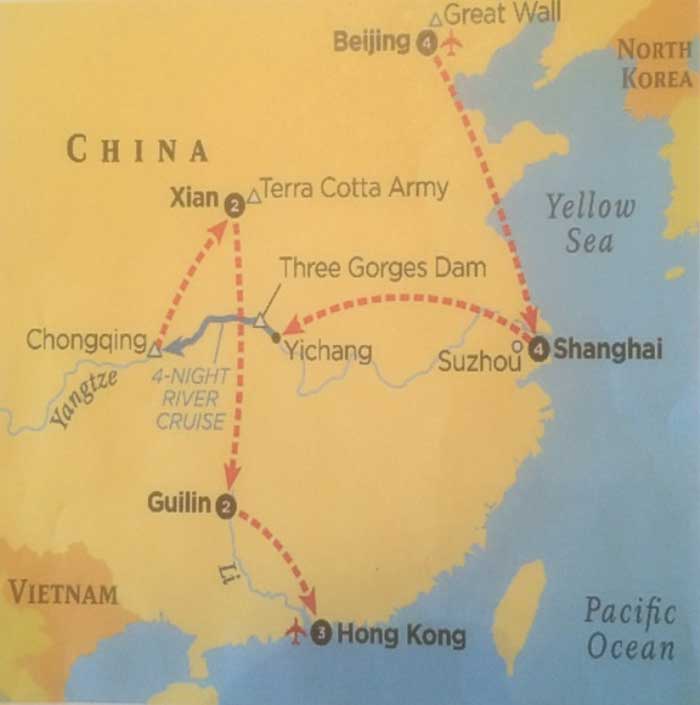The guided trip to China was with Grand Circle Travel, titled China and the Yangtze River, a 21-day adventure. There were 38 travelers in our group. Eight of us had traveled together to Europe several times as part of the Objectivist Travelers several years ago, so it was nice having ready-made friends
Many thanks to Katherine Smyth, Alice Mayer, and Gralee Paar for sharing some of their pictures for this site.
Here is where we went in China. The numbers are the number of nights in each location.

For information on China and its fascinating history, see the Lonely Planet China Travel Guide.
Very, very brief notes on the history of China.
Excerpts are from Grand Circle Travel Discovery Series and the Lonely Planet Guide to China.
China is the second largest nation in the world in land area, after Canada. With a population of 1.3 billion (four times that of the United States), it comprises a quarter of the world’s inhabitants. China is the birthplace of four major inventions (among many, many others): the magnetic compass, papermaking, moveable-type printing, and gunpowder. All are significant contributions to world civilization.
It has a longer continuous history than any other country – over 4,000 years, during most of which the settled peoples of the “Middle Kingdom” along the Yellow, Wei, and Yangtze Rivers have struggled against frequent invasions by nomadic people from the north. China has, for much of its history, been in conflict either internally or with outsiders.
From the earliest recorded times China was ruled by dynasties, or families of rulers who handed down power from one generation to another over hundreds of years. The earliest recorded dynasty, the Zhou, controlled the Middle Kingdom between 1027 and 221 BC.
Power was centralized under the succeeding Qin dynasty, and the national identity began to emerge. The first Qin ruler (Emperor) extended the road and canal network and standardized the written language, currency, and measures.
To keep out raiding Mongol and Hun tribes from the north, the Emperor had existing defenses joined up to form the Great Wall (221-206 BC). The terrible hardships endured by the thousands of conscripted laborers working on the Wall caused rebellion and civil war. In reality, the wall never really accomplished its purpose.
During the Han dynasty (206BC to 220AD) an ideal of a united China was created. The “people of Han” is a name by which the Chinese are commonly known today.
Another massive project, again using conscripted laborers, was the building of the Great Canal – 1,104 miles long – which spanned several centuries. The world’s longest canal once meandered from Beijing to Hangzhou, and is a striking example of China’s engineering prowess. Sections of the canal have been silted up for centuries. The canal enabled the government to capitalize on the growing wealth of the Yellow River Basin and to ship supplies from south to north.
In the 13th century, merciless Mongol leader Chinggis Khaan conquered all China. After many years of unrest the Mongols were finally pushed back to the northern plains.
Fast forward to the 20th century, and there were rebellions (e.g. Boxer Rebellion), World War II, Japanese invasion, the Korean War, the Great Leap Forward by Chairman Mao Zedong and resulting famine accounting for nearly 30 million deaths, the Cultural Revolution with its Red Guards, and current uncertainty about whether modernization goals can be achieved with the current political system.
In China, all property is owned by the government. You just “lease” the land for your store or office building or factory. There is still much government control over the lives of its citizens.
Our program director for the tour was Sally Qu, the best director I have ever encountered in my travels. If you ever have a chance to take a tour with her, I highly recommend it.

This was a very educational tour. Every day, along with the daily itinerary, Sally would give us a handout about the history and culture of what we were going to see. These were part of the Grand Circle Travel Discovery Series.
We were each given a receiver to hang around our neck along with ear buds. The tour guide (either Sally or the local guide) would speak in a normal voice into their microphone and we could hear what they were saying, even in a noisy and crowded tourist area. They called the technology “Whisper.” It was sooo much better than having a speaker or bull horn blast away with sound to destroy the atmosphere and other visitors.
One aspect of the tour was that we were told to drink only bottled water or hot tea. In all the hotels we stayed in, there were notices that the tap water was not fit to drink, and they furnished us two bottles of water every day.
With that, our first visit was to Beijing. Go to the Beijing page from the drop down menu.
